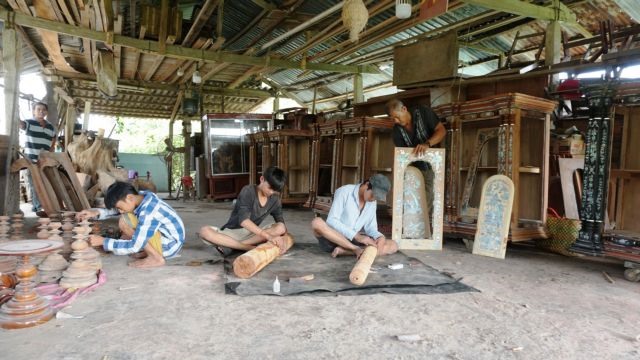

As Tết approached, lots of woodwork was being done. It was to make special altar cabinets people like to have in their houses.
As Tết approached, lots of woodwork was being done.
It was to make special altar cabinets people like to have in their houses.
Some carpenters worked through the night.
Cabinets are made in different sizes and are sold for different prices.

|
Artisans from the Gò Công Altar Cabinet Village in Tiền Giang Province are busy with orders for the Tết (Lunar New Year) holiday.— VNS Photo Ngọc Diệp
by Ngọc Diệp
Craft artisans from the Gò Công Altar Cabinet Village in the Mekong Delta province of Tiền Giang are working hard to meet the increasing number of orders before the Tết (Lunar New Year) holiday.
Located 60km from HCM City, the crafts village has existed for more than 100 years in Tân Trung Commune's Ông Non Hamlet in Gò Công Town.
According to older residents, the village's origins can be traced to four brothers of carpenter Vương Văn Non, who migrated from the country's northern region to Gò Công in the mid-19th century.
The Non brothers developed and taught carpentry skills to people in the area. As more residents began to make a living from making altar cabinets, the village evolved into a traditional craft with the famous brand name, the Gò Công Altar Cabinet Village.
As one of the oldest craft villages in the province, it now employs more than 2,000 regular and seasonal workers.
With over 40 years of experience, artisan Đặng Thành Tân, 54, said he began learning altar cabinet carpentry when he was a child and has since passed down the secrets of the trade to the younger generation.
“If you love your job, you will do it very well,” Tân said.
The altar cabinets, which retain their traditional character, are made mainly of wood and inlaid with mother-of-pearl. The cabinet parts are connected with wooden nails.
Of the many types of wood used to make the cabinet, ebony is the best choice, according to Tân.
“What makes our products beautiful and different from other localities is the encrusting technique used for the mother-of-pearl inlay,” he said.
During the peak season of Tết, village carpenters often have to work through the night to meet orders.
Despite the high demand, the village, like many others, had at times experienced difficult periods during domestic and global economic slowdowns, Tân said.
Previously, the artisans only made encrusted mother-of-pearl pictures of flowers on the front of the cabinets, but now they also depict folktales, famous places and beautiful landscapes.
In the past, one worker would take at least one month to make a cabinet with hand tools, but the work today is divided into stages with the support of electric woodworking tools. It now takes about a week to finish one piece.
The village has about 500 workshops and households making altar cabinets, according to Phạm Văn Nam, director of the Gò Công Altar Cabinet Cooperative.
About 5,000-6,000 altars are made every year.
“The craft offers stable jobs and incomes for hundreds of local workers,” he said.
Each craftsperson can earn an average of VNĐ200,000-250,000 (US$8.5-10) per day, even up to VNĐ400,000 ($18) per day.
Luckily, the village has enough young people who want to carry out the tradition.
Many local children aged 10-15 in the village are studying how to make altar cabinets during their free time.
“They are keeping the craft alive and will develop it over time,” Nam said.
Besides ancestors’ altar cabinets, the village also makes a variety of wooden products such as tables, chairs, worship objects (incense burners, candle stands, flower vases and trays for displaying fruits) and other home decor.
Võ Văn Bừng, 55, the owner of a manufacturing facility and two furniture shops, said his family had been involved in the woodworking craft for four generations.
Rising customer demand usually occurs in the last three months of the year, increasing by 30 per cent compared with normal days.
“Sometimes I can't meet the rising demand and we have to order products from other workshops,” he said.
Because of the Vietnamese tradition of ancestor worship, the altar cabinet is an important piece of furniture for many homes. Most Vietnamese families place the cabinet in the most solemn position in their home.
“During Tết, Vietnamese often buy new worship objects to bring luck and prosperity,” Bừng said. "Many customers from other localities visit our shops to buy our famous altar cabinets."
The price of an altar cabinet can range from tens of millions đồng to more than 100 million đồng, depending on the material, design and size.
A customer from HCM City, for example, ordered an altar cabinet with a special design worth more than VNĐ750 million ($32,000).
Besides the altar cabinet village, there are 12 other traditional craft villages in the province, with a total of more than 5,000 workers, according to Đoàn Văn Phương, director of the province's Department of Industry and Trade.
The Gò Công Altar Cabinet Village is one of the most famous traditional craft villages in the region.
Its products are sold nationwide.
“This traditional craft, compared to the others, provides the highest income for local workers,” he said. An artisan can earn VNĐ8-10 million ($345-430) per month.
Besides providing a sustainable source of income, the woodworking craft has contributed greatly to the national new-style rural area programme and has improved living standards in rural areas in the province.
The Gò Công Altar Cabinet Village is one of many traditional craft villages that have been preserved, and is expected to become a tourism destination in the future, according to Phương. VNS
GLOSSARY
Craft artisans from the Gò Công Altar Cabinet Village in the Mekong Delta province of Tiền Giang are working hard to meet the increasing number of orders before the Tết (Lunar New Year) holiday.
A craft is an activity that involves making things by hand and using a skill.
An artisan is someone who works with his, or her hands, often using them to operate tools.
Located 60km from HCM City, the crafts village has existed for more than 100 years in Tân Trung Commune's Ông Non Hamlet in Gò Công Town.
If the crafts have existed for more than 100 years, they have been around for that amount of time.
According to older residents, the village's origins can be traced to four brothers of carpenter Vương Văn Non, who migrated from the country's northern region to Gò Công in the mid-19th century.
The origins of a village are its beginnings.
To migrate from one place to another means to move between those places, usually to start a new home.
As more residents began to make a living from making altar cabinets, the village evolved into a traditional craft with the famous brand name, the Gò Công Altar Cabinet Village.
Evolve means “develop slowly over time”.
As one of the oldest craft villages in the province, it now employs more than 2,000 regular and seasonal workers.
Employs means “gives work to”, or “provides jobs to”.
Regular workers are those with jobs they go to all year round.
Seasonal workers are people who work only at certain times of year.
The altar cabinets, which retain their traditional character, are made mainly of wood and inlaid with mother-of-pearl.
Retain means “keep”
Inlaid means “decorated by being placed into the surface (of the wood)”.
Mother-of-pearl is a shiny part of a sea shell.
The cabinet parts are connected with wooden nails.
Connected means “joined together”.
“What makes our products beautiful and different from other localities is the encrusting technique used for the mother-of-pearl inlay,” he said.
An encrusting technique is a way of decorating something with a hard surface layer.
Despite the high demand, the village, like many others, had at times experienced difficult periods during domestic and global economic slowdowns, Tân said.
Demand means the extent to which people want something.
Domestic means within a country. In this case, it means “within Viet Nam”.
Global means “involving the whole world”.
An economic slowdown happens when business becomes very slow.
Previously, the artisans only made encrusted mother-of-pearl pictures of flowers on the front of the cabinets, but now they also depict folktales, famous places and beautiful landscapes.
Depict means “show”.
Folktales are traditional stories.
“The craft offers stable jobs and incomes for hundreds of local workers,” he said.
Stable jobs are jobs that last for a long time.
Besides ancestors’ altar cabinets, the village also makes a variety of wooden products such as tables, chairs, worship objects (incense burners, candle stands, flower vases and trays for displaying fruits) and other home decor.
Your ancestors are your parents, grandparents, great grandparents and so on.
A variety of wooden products means “many, different types of wooden products”.
Décor is decoration.
Võ Văn Bừng, 55, the owner of a manufacturing facility and two furniture shops, said his family had been involved in the woodworking craft for four generations.
A manufacturing facility is a place where things are made, such as a factory or workshop.
You and your brothers and sisters are one generation. Your parents and your uncles and aunts (their brothers and sisters) are another and your grandparents and their brothers and sisters are yet another generation, and so on.
Most Vietnamese families place the cabinet in the most solemn position in their home.
Solemn means formal and worthy of honour.
The Gò Công Altar Cabinet Village is one of many traditional craft villages that have been preserved, and is expected to become a tourism destination in the future, according to Phương.
Preserved means “kept”.
WORKSHEET
State whether the following sentences are true, or false:
ANSWERS: 1. True; 2. False; 3. True; 4. True; 5. False.









